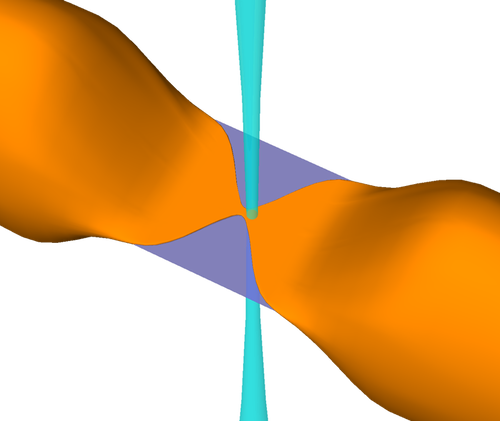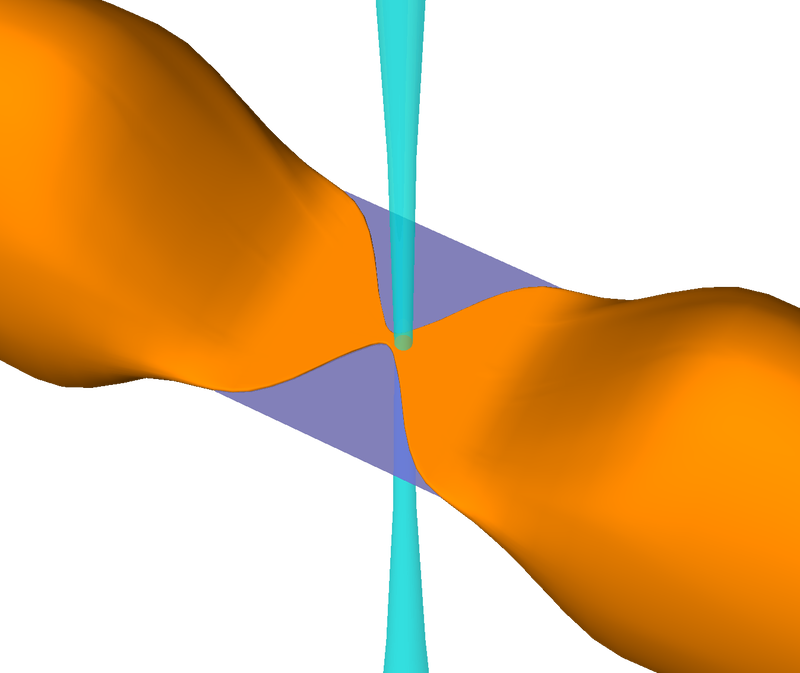New View of Cold Atoms Flowing
Physicists routinely exploit the quantum properties of ultracold atomic gases in building powerful sensing devices or in simulating the behavior of other quantum systems. But they still lack a good way to image the flow of cold atoms that are used in these experiments. So a research team has now developed a scanning microscope that has produced the first image of the flow of cold atoms through a microscopic channel. The technique could be essential in imaging and controlling the delicate flow of cold atoms in an emerging technology called atomtronics.
When cooled to microkelvin temperatures, a gas of atoms takes on quantum properties. In flowing through a narrow channel, for example, atoms act as waves able to interfere with one another. In addition, cold-atom interactions can be tuned to mimic a wide variety of other quantum systems, often greatly simplifying the study of subtle phenomena. Examples include so-called topological insulating solids, which conduct current only at their surfaces, and the ring-like flows of superfluids used in ultrasensitive rotation detectors.
Yet while researchers can easily map the static properties of a cold gas—such as the atomic density—when it comes to motion of atoms, they have only been able to measure crude properties, such as the total flow of atoms between two regions. A lack of more detailed spatial information on flows has hampered the study of more complex quantum dynamics. Now a team of physicists has shown how to make such measurements by using a variant of scanning probe microscopy, which is widely used to map electron flows in solid materials. In a proof-of-principle demonstration, Samuel Häusler of the Swiss Federal Institute of Technology (ETH) in Zurich and colleagues have successfully mapped out the two-dimensional pattern of atomic flow through a microscale channel.
The team started by creating an atomic flow using a gas of ultracold lithium atoms held in an ellipsoidal trap. They first applied a laser field to confine the central portion of the gas within a flat sheet. Using another laser, they pinched the center of the sheet, restricting atomic motion there to a narrow channel less than one micrometer wide that connected atomic reservoirs on either end. The channel was narrow enough that the atoms acted as waves in flowing between the reservoirs.
To map this flow, they used a third laser, perpendicular to the channel and focused to a small spot, to act as an energetic barrier to the atomic motion. They could precisely place this barrier anywhere inside or outside the channel and could adjust the laser to make the barrier weaker or stronger. The team then moved this barrier over all parts of the channel while simultaneously measuring the flow of atoms between the reservoirs.
Demonstrating that the barrier technique works as expected, they showed that a strong barrier placed directly in the channel center cuts off the flow entirely, while a barrier placed near the channel walls has little effect. A weak barrier in the channel reduces flow, but some atoms still get through. The team also confirmed that those atoms getting through the weak barrier do so via quantum tunneling, a phenomenon exclusive to waves. Overall, the measurements closely matched the detailed predictions of basic quantum theory.
“Previous techniques could give information on the total conductance of a system, or how much current it carries,” says team member Jean-Philippe Brantut of the Swiss Federal Research Institute in Lausanne. “Our technique goes beyond this to give a detailed map.”
The weaker the barrier, the less it disturbs the flow, so weak barrier maps should be the most accurate, says Brantut. In this regime, he suggests, the technique may be useful for probing complex atomic flows in future “atomtronics ”devices that exploit atomic matter waves to carry out information processing.
“This advance adds spatial resolution to the study of quantum transport,” says condensed matter theorist Dietmar Weinmann of the Institute of the Physics and Chemistry of Materials in Strasbourg, France. Weinmann points out that understanding the influence of strong barriers on atomic motion will also be useful, as they offer a means to manipulate atomic flows, which is essential for engineering future devices that use matter waves. “This advance,” says Weinmann, “is of importance in the fundamental research aiming at a better understanding of quantum transport.”
This research is published in Physical Review Letters.
–Mark Buchanan
Mark Buchanan is a freelance science writer who splits his time between Abergavenny, UK, and Notre Dame de Courson, France.





